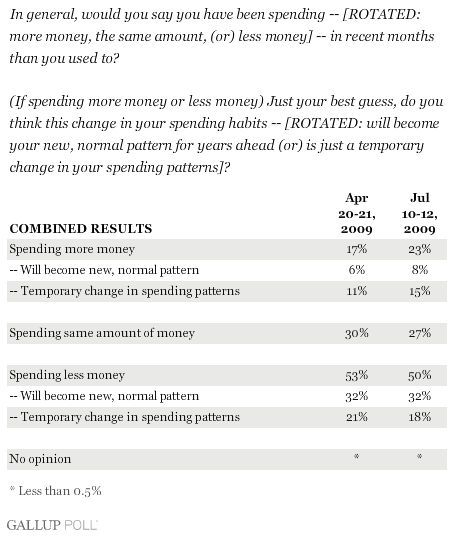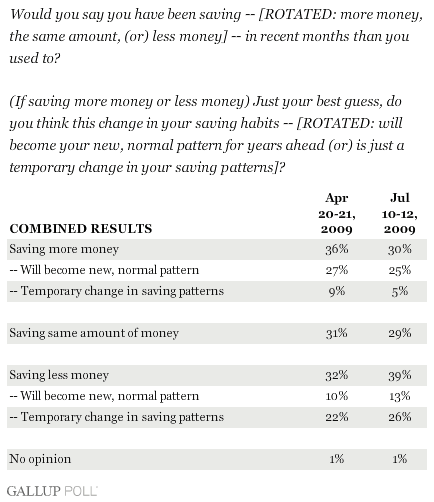PRINCETON, NJ -- A new Gallup Poll shows 32% of Americans reporting that their recently depressed spending habits will become a "new normal" in the years ahead. These Americans say they have been spending less and plan on continuing that pattern in the future. Eight percent say their new normal will be spending more in the years ahead.
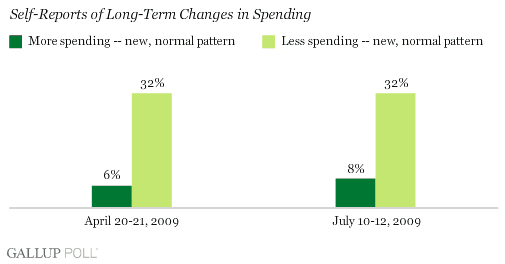
These results are little changed from April, when Gallup first asked these questions. This suggests there has been no further deterioration in Americans' projections of restrained future spending as the recession has worn on over the last two and a half months, but of course no major shift in the other direction, either.
The impact of these results on the future of the U.S. consumer economy is a matter of interpretation. Clearly there will be at least some negative repercussions on consumer spending going forward. But at the same time, two-thirds of Americans say that they have not changed their spending habits, that their spending changes in recent months will not be permanent in the years ahead, or that they will actually be spending more.
The precise real-world impact of Americans' stated intentions to decrease their spending also depends on how much these individuals were going to spend in the first place. The economy would be affected more by a decrease in spending among previously high-rolling millionaires or affluent suburban families than it would be by a downward shift among the same number of low-income, low-spending senior citizens.
There is no measure in the two Gallup surveys of the amount of money respondents typically spend or have spent in the past. There is also no indication of the exact dollar amount involved when survey respondents say they will spend "more" or spend "less." Still, a suggestion of the impact of changes in spending behavior is provided by analyzing the results within income groups.
The accompanying table displays by income the percentage of those saying their new normal is to spend more or to spend less in the years ahead, based on a combined sample of those interviewed in Gallup's April and July surveys. While one might expect there to be differences in the impact of the recessionary economy across income groups, that is not the case. There is little substantive variation by income in the percentage saying their new normal is to spend less. Those with lower incomes are slightly more likely than higher-income Americans to say their new normal pattern is spending more, but not by much.
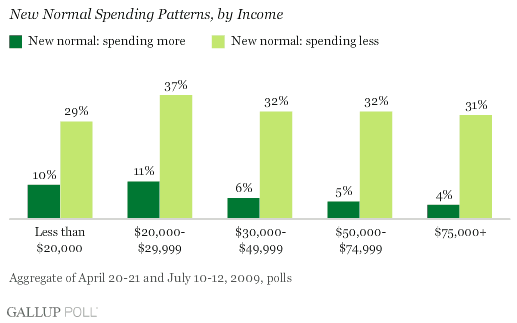
It can be assumed that those in the highest income groups on average spend the most money. Therefore it is perhaps good news that high-income Americans are not above the overall average in terms of saying their new normal is to spend less, assuming that such behavior would have a heightened impact on the economy as income increases.
All in all, the results of the April and the July Gallup surveys are consistent in indicating that about a third of Americans, across the income spectrum, say they will spend less in the years ahead -- presumably regardless of improvements in the economy. That "spend less" new normal is slightly counterbalanced by the 6% to 8% in the two surveys who say their new normal will be to spend more.
One in Four Americans Say Saving More Is New Normal
The July data on Americans' changes in saving patterns more or less reconfirm Gallup's April report, which concluded that the implications of these changes were "mixed."

There has been little change between the April and July surveys. In both, about a quarter of Americans say they have recently been saving more, and that this will become their new, normal pattern in the years ahead. Between 10% and 13% say they have been saving less, and that this will be their new normal. This presumably suggests some harm, albeit modest, to consumer spending in the long run if these projections hold and Americans in fact do save more. (Of course, some observers conclude that saving more would be a positive for American families -- despite the possible deleterious effect on retailers.)
The data on saving across income groups show more variation than was the case for spending.
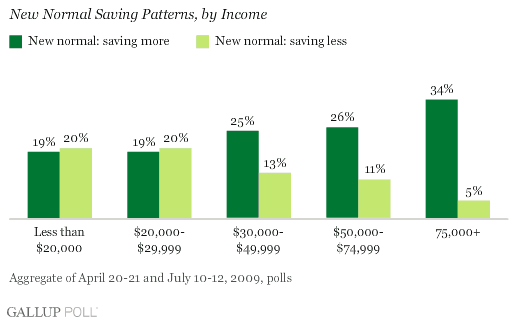
It is clear that higher-income Americans are most likely to say that their new, normal pattern is to save more in the years ahead. And, there is a comparative tendency for those with lower incomes to say their new, normal pattern is to save less in the years ahead. These patterns are not unexpected. Lower-income Americans have less discretionary income. They may not save much to begin with and/or don't have enough income to even consider the possibility of saving more in reaction to a recession. The fact that they are slightly more likely to say they will be saving less suggests a tendency to worry about being able to put money away in the future.
Implications
There have been no significant changes since April in the self-reported "new normal" spending and saving intentions of Americans when they are asked to look into their crystal balls and project into the future. About a third say they will spend less in the years ahead. About a quarter say they will save more. These self-reported intentions are counterbalanced to some degree by the finding that smaller percentages of Americans say they will actually spend more and, separately, will save less in the years ahead.
As Gallup noted in April, when these self-assessments were first measured, it is difficult to know how firmly Americans will stick to their projections when the economy does pick up and unemployment drops. Good intentions to restrain spending and to save more could go out the window if the U.S. returns to flush and vibrant economic times. It is also difficult to measure the exact monetary implications of these future actions, given that an individual's claim that he or she is going to spend less could range from very modest cutbacks in the amount spent on lattes at Starbucks to wholesale cutbacks on purchases of new cars, major appliances, and vacation trips.
Still, multiplied across tens of millions of American households, even a small reduction in spending, perhaps coupled with a small increase in saving, could have a major effect on the consumer economy in the years ahead. And these data suggest that if one takes Americans at their word, there will be at least some shift in the nation's economy to a "new normal" of more restrained consumer economic activity for some time to come.
Survey Methods
Results are based on telephone interviews with 1,018 national adults, aged 18 and older, conducted July 10-12, 2009. For results based on the total sample of national adults, one can say with 95% confidence that the maximum margin of sampling error is ±3 percentage points.
Interviews are conducted with respondents on land-line telephones (for respondents with a land-line telephone) and cellular phones (for respondents who are cell-phone only).
In addition to sampling error, question wording and practical difficulties in conducting surveys can introduce error or bias into the findings of public opinion polls.
